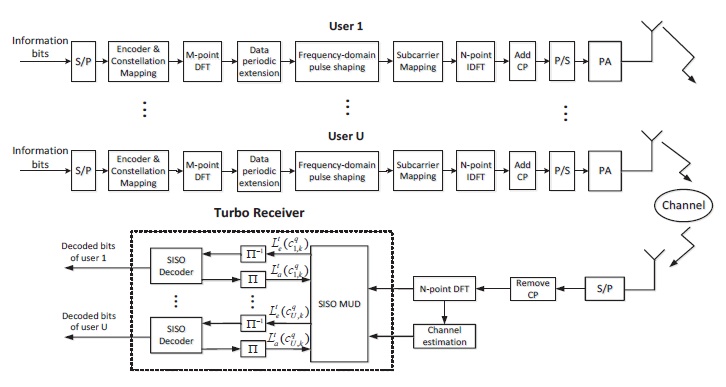- ALL COMPUTER, ELECTRONICS AND MECHANICAL COURSES AVAILABLE…. PROJECT GUIDANCE SINCE 2004. FOR FURTHER DETAILS CALL 9443117328


Projects > ELECTRONICS > 2017 > IEEE > COMMUNICATION
One major concern of employing frequency-domain pulse shaping (FDPS) to reduce the peak-to-average power ratio of single carrier frequency division multiple access (SCFDMA) signals is the decrease of system spectral efficiency due to the excess bandwidth wasted in existing band allocation schemes (BASs). To improve the spectral efficiency of FDPS based SC-FDMA systems, a novel BAS is proposed, where edge subcarriers for each user are overlapped with those of all its neighbours. However, the spectrum-overlapping incurs multiuser interference and degrades the bit error rate (BER) performance. To address this problem, two iterative multiuser detection (MUD) algorithms are proposed based on expectation propagation (EP), termed joint EP (J-EP) and distributed EP (D-EP), respectively. Simulation results demonstrate that, aided by either of the EP based MUD algorithms, the FDPS-based SC-FDMA system with the proposed BAS can work more spectral-efficiently without BER performance degradation compared to those with existing BASs. In addition, the D-EP algorithm performs nearly the same as J-EP but requires much lower complexity, making it more appealing for large numbers of allocated subcarriers.
Metric-Based Symbol Predistortion Techniques, Turbo Equalization.
In this paper, the major concern of FDPS-based SC-FDMA systems with existing BASs is the increased system bandwidth, which decreases the spectral efficiency. Motivated by this, we focus on the design of novel BAS in this paper to avoid the loss of spectral efficiency when using the FDPS method for PAPR reduction of SC-FDMA signals. The main contributions of this work are as follows: We propose a spectral-efficient BAS for FDPS-based SCFDMA systems by spectrum overlapping. In the proposed BAS, edge subcarriers for each user overlap with all its neighbours so that the bandwidth consumed by all users is the same as that of conventional SC-FDMA systems. With the proposed BAS, we formulate the signal model with an effective channel matrix, based on which we can perform one-step detection directly on the frequency domain received signal to obtain the estimates of original data symbols. To tackle the MUI incurred by spectrum-overlapping in the novel BAS, we propose two iterative multiuser detection (MUD) algorithms based on expectation propagation (EP), which has drawn lots of interest in wireless communications to deal with interference problems. In the first algorithm called joint EP (J-EP), we represent the joint distribution by a factor graph (FG) consisting of a vector-form channel node and separate variable nodes, based on which the EP principle is used for message updating. To avoid matrix inversion in J-EP, we modify the FG via breaking the vector-form channel node into corresponding scalar ones and propose a low complexity alternative named distributed EP (D-EP). Finally, numerical results are provided to show the validity of the proposed BAS and EP-based MUD algorithms. Aided by either the J-EP or D-EP algorithm, FDPS-based SC-FDMA systems with the proposed BAS can achieve a higher spectral efficiency without BER degradation compared to those with existing BASs.
FDPS-based SC-FDMA system with turbo receiver
